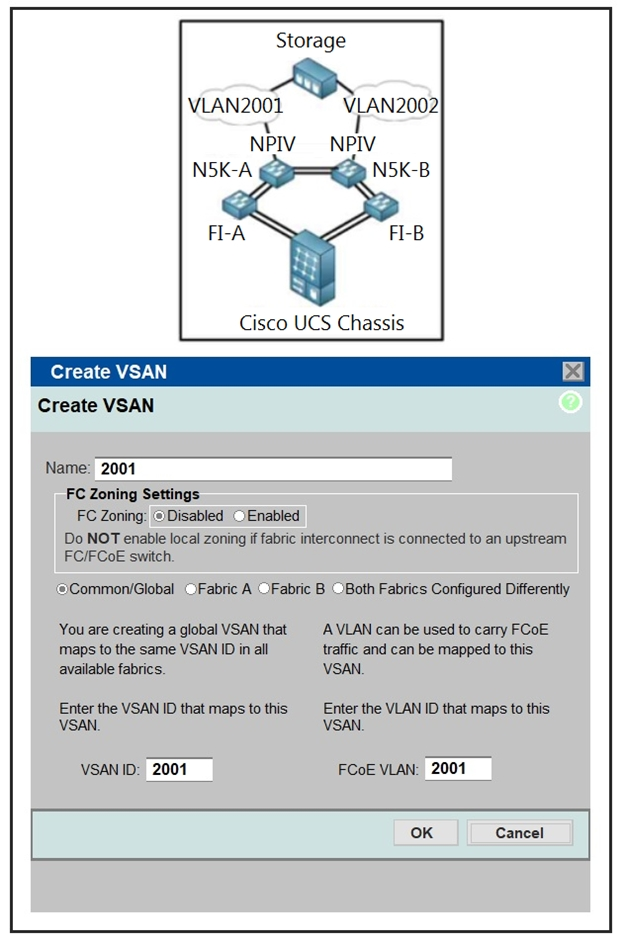
Refer to the exhibit. An engineer is configuring a VSAN on the network. Which option must be selected to create the VSAN?

Refer to the exhibit. An engineer is configuring a VSAN on the network. Which option must be selected to create the VSAN?
To create a VSAN on the network, the configuration should be limited to a single fabric when using the same VSAN ID and FCoE VLAN ID across the infrastructure. In this scenario, the VSAN ID and FCoE VLAN ID are both set to 2001, indicating that the configuration applies to only one fabric rather than both. Therefore, selecting 'Fabric A' is the correct approach. This ensures that the identifiers do not conflict across the fabrics, adhering to best practices for network stability and avoiding potential faults and traffic disruptions.
The answer is D. Choice C is incorrect because the config screen shown is from UCS Manager, referenced as FI-A and FI-B devices on the topology diagram, which uplink to the Nexus switches for FC or FCoE traffic.
The answer must be D. https://www.cisco.com/c/en/us/td/docs/unified_computing/ucs/ucs-central/GUI-User-Guides/Storage-Mgmt/1-5/b_CiscoUCSCentral_Storage_Management_Guide_1-5/b_CiscoUCSCentral_Storage_Management_Guide_1-5_chapter_011.pdf
You can create a VSAN at the domain group root or in a specific domain. You can also assign the VSAN to either fabric A or fabric B, or to both fabric A and B. When you assign the VSAN to both fabrics, both of them must have different VSAN ID and FCoE VLAN ID. from the link you provided, answer must be D
Actually I think A is a valid answer, you can see the interconnection between Nexus where they can share both vlans using a trunk between them. The warning on the usage of vlan id and vsan id is more related not to mix fcoe traffic by mixing vlans id, anyway D would also be valid.
D is the one.
According to diagram, 2001 is for Fabric A, look upstream
The diagram shows that the UCS chassis is connecting to a pair of Nexus 5ks, which means FCoE is used, and that is confirmed by the "NPIV" legend that the diagram shows. Hence, how can this legend be ignored: "Do NOT enable local zoning if fabric interconnect is connected to an upstream FC/FCoE switch." --> That would invalidate C as an option. The answer would be D, based on: "When you assign the VSAN to both fabrics, both of them must have different VSAN ID and FCoE VLAN ID" and considering that in the diagram, VSAN ID and FCoE VLAN ID are 2001, which forces to put that config on only one fabric
Why not D?
The correct answer is D: • Fabric A—The VSAN maps to the a VSAN ID that exists only in fabric A. https://www.cisco.com/c/en/us/td/docs/unified_computing/ucs/sw/gui/config/guide/2-2/b_UCSM_GUI_Configuration_Guide_2_2/configuring_fibre_channel_zoning.pdf
D is the one.
VLANs in the LAN cloud and FCoE VLANs in the SAN cloud must have different IDs. Using the same ID for a VLAN and an FCoE VLAN in a VSAN results in a critical fault and traffic disruption for all vNICs and uplink ports using that VLAN. Ethernet traffic is dropped on any VLAN which has an ID that overlaps with an FCoE VLAN ID. does this mean i have to assign it to fabric B?
C is the correct